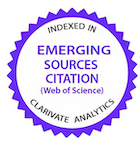Interação genótipo ambiente em provas de ganho em peso de ovinos confinados e a pasto
DOI:
https://doi.org/10.5216/cab.v13i2.5658Palavras-chave:
área de lombo, avaliação subjetiva, ganho de peso, índice, espessura de gordura, ultra-somResumo
Objetivou-se com este trabalho verificar a existência de interação genótipo ambiente e o desempenho de ovinos mantidos em confinamento e a pasto. Foram utilizados oitenta e dois borregos da raça Santa Inês de 75 a 135 dias de idade. O período de adaptação foi 22 dias. Oriundos de cinco fazendas diferentes, 30 animais permaneceram 112 dias a pasto e 52 animais permaneceram 85 dias sob regime de confinamento. As características mensuradas nos animais foram ganho em peso(GP), comprimento do corpo (CC), perímetro torácico (PT), altura da anca (AA), altura do peito (AP), área de olho de lombo (AOL) e espessura de gordura por ultrassom (EG), perímetro escrotal (PE), número ovos/grama de fezes (OPG) e escore corporal (EC). Um índice (IPGP) foi criado incorporando as características medidas. O software SAS® foi utilizado para as análises estatísticas. Houve diferença entre os animais para o tipo de teste (confinamento ou pasto) para as características GP, AOL, EG, PE e IPGP. Os animais em confinamento apresentaram resultados superiores aos do pasto para as características de ganho em pesoe inferiores para o IPGP e PE. A idade dos animais no início do teste não mostrou influencia sobre a expressão das características. Não houve evidência de interação genótipo x ambiente para animais da raça Santa Inês nas provas de ganho em pesoa pasto e em confinamento para as características avaliadas.
PALAVRAS-CHAVE: área de lombo; avaliação subjetiva; espessura de gordura; índice; ultrassom.
Downloads
Downloads
Publicado
Como Citar
Edição
Seção
Licença
Copyright (c) 2012 Ciência Animal Brasileira / Brazilian Animal Science

Este trabalho está licenciado sob uma licença Creative Commons Attribution 4.0 International License.
Autores que publicam nesta revista concordam com os seguintes termos:
- Autores mantém os direitos autorais e concedem à revista o direito de primeira publicação, com o trabalho simultaneamente licenciado sob a Licença Creative Commons Attribution que permite o compartilhamento do trabalho com reconhecimento da autoria e publicação inicial nesta revista.
- Autores têm autorização para assumir contratos adicionais separadamente, para distribuição não-exclusiva da versão do trabalho publicada nesta revista (ex.: publicar em repositório institucional ou como capítulo de livro), com reconhecimento de autoria e publicação inicial nesta revista.
- Autores têm permissão e são estimulados a publicar e distribuir seu trabalho online (ex.: em repositórios institucionais ou na sua página pessoal) a qualquer ponto antes ou durante o processo editorial, já que isso pode gerar alterações produtivas, bem como aumentar o impacto e a citação do trabalho publicado (Veja O Efeito do Acesso Livre).






























